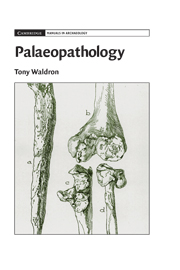Book contents
- Frontmatter
- Contents
- List of Figures
- Preface
- 1 Introduction and Diagnosis
- 2 Bone Metabolism and Pathology
- 3 Diseases of Joints, Part 1
- 4 Diseases of Joints, Part 2
- 5 Bone forming and DISH
- 6 Infectious Diseases
- 7 Metabolic Diseases
- 8 Trauma
- 9 Tumours
- 10 Disorders of Growth and Development
- 11 Soft Tissue Diseases
- 12 Dental Disease
- 13 An Introduction to Epidemiology
- Select Bibliography
- Index
- References
7 - Metabolic Diseases
Published online by Cambridge University Press: 05 June 2012
- Frontmatter
- Contents
- List of Figures
- Preface
- 1 Introduction and Diagnosis
- 2 Bone Metabolism and Pathology
- 3 Diseases of Joints, Part 1
- 4 Diseases of Joints, Part 2
- 5 Bone forming and DISH
- 6 Infectious Diseases
- 7 Metabolic Diseases
- 8 Trauma
- 9 Tumours
- 10 Disorders of Growth and Development
- 11 Soft Tissue Diseases
- 12 Dental Disease
- 13 An Introduction to Epidemiology
- Select Bibliography
- Index
- References
Summary
There are a number of diseases that interfere with the normal metabolism of the skeleton. They include osteoporosis, Paget's disease, rickets and osteomalacia, and scurvy. Some conditions in which there is a hormonal imbalance also affect bone and some of these will be considered in this section.
OSTEOPOROSIS
Until early adult life the skeleton is in positive balance, that is to say, a larger amount of bone is formed than is lost and the total skeletal mass increases until it reaches a maximum at about the age of 25–30. The absolute value of the maximum bone mass (MBM) varies from individual to individual and is dependent on a number of factors including sex, activity, diet and race. After the MBM is achieved the skeletal balance is reversed and there is a net loss of bone during the following years. Women lose bone at a faster rate than men at all ages but their rate of loss increases after the menopause when the depressing effect of oestrogen on the osteoclast is lost. Bone is lost more rapidly at some sites than others, and the rate of trabecular bone loss tends to be greater than the rate of cortical bone loss. If the rate of bone loss becomes too great, and particularly if much trabecular bone is lost, the risk of a fracture occurring is considerable, especially of those bones that contain a great deal of trabecular bone, most notably the distal radius, the femoral neck and the vertebrae.
- Type
- Chapter
- Information
- Palaeopathology , pp. 118 - 137Publisher: Cambridge University PressPrint publication year: 2008

